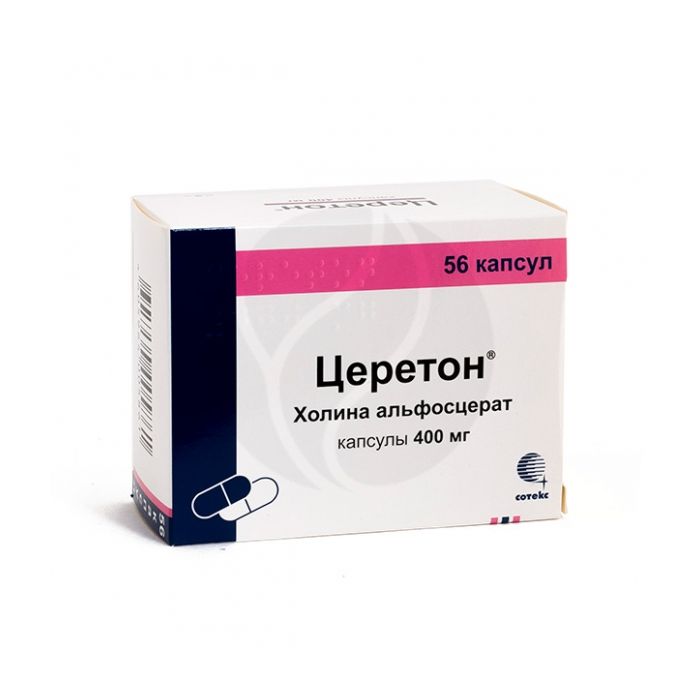Cereton capsules 400mg, No. 56
Expiration Date: 05/2027
Russian Pharmacy name:
Церетон капсулы 400мг, №56
- the recovery period of severe traumatic brain injury and ischemic stroke, the recovery period of hemorrhagic stroke, occurring with focal hemispheric symptoms or symptoms of brain stem damage;
- psychoorganic syndrome against the background of degenerative and involutional changes in the brain;
- Cognitive disorders (impaired mental function, memory, confusion, disorientation, decreased motivation, initiative and ability to concentrate), including dementia and encephalopathy;
- senile pseudomelancholia.
In the recovery period of traumatic brain injury, ischemic or hemorrhagic stroke, CeretonЃ is prescribed 800 mg in the morning and 400 mg in the afternoon for 6 months.
In chronic cerebrovascular insufficiency and dementia syndromes, Cereton is prescribed 400 mg (1 capsule) 3 times a day, preferably after meals, for 3-6 months.
1 capsule contains, as an active substance, choline alfoscerate in terms of 100% substance - 400 mg;
excipients: glycerol, purified water;
capsule composition: gelatin, sorbitol, glycerol, methyl parahydroxybenzoate, propyl parahydroxybenzoate, titanium dioxide, iron dye yellow oxide, purified water.
- hypersensitivity to the drug;
- acute stage of hemorrhagic stroke;
- pregnancy; breastfeeding period;
- children under 18 years of age (due to lack of data).
Trade name : CeretonЃ
International non-proprietary name : choline alfoscerate
Dosage form : capsules
Composition : 1 capsule contains, as an active substance choline alfoscerate in terms of 100% substance - 400 mg;
excipients: glycerol, purified water;
capsule composition: gelatin, sorbitol, glycerol, methyl parahydroxybenzoate, propyl parahydroxybenzoate, titanium dioxide, iron dye yellow oxide, purified water.
Description : soft gelatin capsules, oval, yellow or yellow with a light brown shade. The contents of the capsules are oily transparent colorless or slightly colored liquid.
Pharmacotherapeutic group : nootropic agent
ATX code : N07AX02
pharmacological properties
Pharmacodynamics
Nootropic agent. Central anticholinergic stimulant, which contains 40.5% of metabolically protected choline. Metabolic protection promotes the release of choline in the brain. Provides the synthesis of acetylcholine and phosphatidylcholine in neuronal membranes, improves blood flow and enhances metabolic processes in the central nervous system, activates the reticular formation. Increases the linear velocity of blood flow on the side of traumatic brain damage, contributes to the normalization of spatio-temporal characteristics: spontaneous bioelectrical activity of the brain, regression of focal neurological symptoms and restoration of consciousness;has a positive effect on the cognitive and behavioral reactions of patients with vascular diseases of the brain (discirculatory encephalopathy and residual symptoms of cerebrovascular accident). It has a preventive and corrective effect on the pathogenetic factors of the involutional psychoorganic syndrome, changes the phospholipid composition of neuronal membranes: participates in the synthesis of phosphatidylcholine (membrane phospholipid), improves the plasticity of neuronal membranes. Stimulates dose-dependent release of acetylcholine under physiological conditions, improves synaptic transmission, receptor function. It does not affect the reproductive cycle and does not have a teratogenic, mutagenic effect.It has a preventive and corrective effect on the pathogenetic factors of the involutional psychoorganic syndrome, changes the phospholipid composition of neuronal membranes: participates in the synthesis of phosphatidylcholine (membrane phospholipid), improves the plasticity of neuronal membranes. Stimulates dose-dependent release of acetylcholine under physiological conditions, improves synaptic transmission, receptor function. It does not affect the reproductive cycle and does not have a teratogenic, mutagenic effect.It has a preventive and corrective effect on the pathogenetic factors of the involutional psychoorganic syndrome, changes the phospholipid composition of neuronal membranes: participates in the synthesis of phosphatidylcholine (membrane phospholipid), improves the plasticity of neuronal membranes. Stimulates dose-dependent release of acetylcholine under physiological conditions, improves synaptic transmission, receptor function. It does not affect the reproductive cycle and does not have a teratogenic, mutagenic effect.It does not affect the reproductive cycle and does not have a teratogenic, mutagenic effect.It does not affect the reproductive cycle and does not have a teratogenic, mutagenic effect.
Pharmacokinetics
When taken parenterally (10 mg / kg) CeretonЃ is predominantly accumulated in the brain, lungs and liver. Absorption - 88%, easily penetrates the blood-brain barrier (when taken orally, the concentration in the brain is 45% of that in plasma). The lungs excrete 85% of the drug in the form of carbon dioxide, the rest (15%) is excreted by the kidneys and through the intestines.
Indications for use
- the recovery period of severe traumatic brain injury and ischemic stroke, the recovery period of hemorrhagic stroke, occurring with focal hemispheric symptoms or symptoms of brain stem damage;
- psychoorganic syndrome against the background of degenerative and involutional changes in the brain;
- Cognitive disorders (impaired mental function, memory, confusion, disorientation, decreased motivation, initiative and ability to concentrate), including dementia and encephalopathy;
- senile pseudomelancholia.
Contraindications
- hypersensitivity to the drug;
- acute stage of hemorrhagic stroke;
- pregnancy; breastfeeding period;
- children under 18 years of age (due to lack of data).
Dosage and administration
In the recovery period of traumatic brain injury, ischemic or hemorrhagic stroke, CeretonЃ is prescribed 800 mg in the morning and 400 mg in the afternoon for 6 months.
In chronic cerebrovascular insufficiency and dementia syndromes, Cereton is prescribed 400 mg (1 capsule) 3 times a day, preferably after meals, for 3-6 months.
Side effects Nausea
may appear (mainly as a result of dopaminergic activation). Does not require cancellation, a temporary reduction in the dose of the drug is sufficient. Allergic reactions.
Overdose
Nausea may occur. Treatment: symptomatic therapy.
Interaction with other medicinal products
No significant interaction with other medicinal products has been identified.
Special instructions
Cereton does not affect the speed of psychomotor reactions.
Release form
Capsules 400 mg. On 14 capsules in a blister strip packaging.
1 or 2 blisters, together with instructions for use, are placed in a cardboard box.
Storage conditions
List B. In a dry, dark place at a temperature not exceeding 25 ? C. Keep out of the reach of children.
Shelf life is
2 years. Do not use after the expiration date printed on the package.
Terms of dispensing
By prescription.

